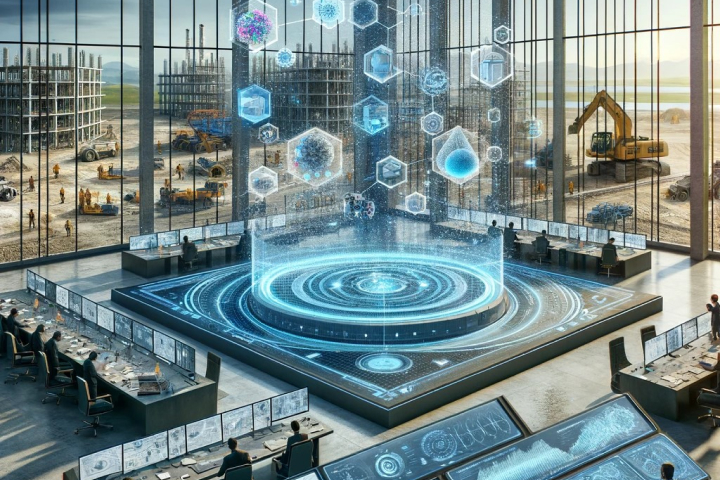
In the bustling world of construction, where concrete lays the foundation for our towering skyscrapers, winding roads, and cozy homes, a team of researchers from Leibniz University Hannover in Germany has embarked on a fascinating journey. Max Meyer, Amadeus Langer, Max Mehltretter, Dries Beyer, Max Coenen, Tobias Schack, Michael Haist, and Christian Heipke have teamed up to solve a puzzle that could very well reshape the future of concrete production. Imagine a world where we could predict the behavior of concrete while it’s still being mixed, much like a baker anticipates the rise of their dough. This isn’t just about ensuring our buildings stand tall and strong; it’s a leap towards slashing the carbon footprint of concrete production, a notorious contributor to global CO2 emissions.
At the heart of their quest lies a cutting-edge technique that sounds like something straight out of a sci-fi novel: using stereoscopic image sequences to peek into the future of fresh concrete. Stereoscopic images, for those who might wonder, are like the magical pictures that seem to come alive, offering a glimpse into the depth that our eyes crave. By feeding these images into a Convolutional Neural Network (CNN) – a type of brainy computer program that’s really good at understanding pictures – the team has crafted a method to predict how concrete will behave before it even sets.
But there’s more to this story. The researchers didn’t stop at just images. They knew that to truly understand the future of concrete, they needed to consider its recipe (mix design) and the ticking clock (temporal data). It’s akin to knowing not just the ingredients of your cake but also how long it’s been in the oven. This holistic approach lets their CNN learn how the properties of concrete change over time, enabling predictions of key characteristics like slump flow diameter, yield stress, and plastic viscosity. These might sound like technical jargon, but they’re essentially the factors that determine whether your concrete will be more like a sturdy chocolate cake or a crumbly sponge cake.
Diving into the meat of their findings, the team embarked on a meticulous journey of testing and retesting their method. They played around with different combinations of data inputs to see what mix would give them the clearest crystal ball. Through a series of cross-validations – a fancy term for making sure their predictions weren’t just flukes – they explored how different types of information affected their ability to foresee the concrete’s behavior.
Their results were intriguing. When they looked at the influence of different data combinations on their predictions, they found that including the mix design information (think of it as the concrete’s DNA) significantly improved their foresight for certain properties. It was a bit like realizing that knowing a little more about the origins of your ingredients could help you bake a better cake. They also noticed that optical flow images, which capture the movement within the concrete, were particularly helpful. However, the inclusion of orthophotos, which are essentially detailed aerial snapshots, seemed to muddy the waters. This was a curious find, suggesting that sometimes more information isn’t always better.
One of the most enlightening parts of their journey was the discovery that averaging multiple predictions could sharpen their foresight. It’s akin to asking several friends to guess the outcome of a game and then taking the average of their guesses. This approach suggested that some errors might just be noise, random misfires that could be smoothed out by looking at the bigger picture.
But perhaps the most captivating part of their adventure was the development of a continuous prediction model. This wasn’t just about making a one-off guess; it was about tracking the changing face of concrete over time, minute by minute. The researchers showed that their model could capture the dance of the slump flow diameter – a measure of concrete’s fluidity – as it evolved from the moment of mixing. It painted a picture of concrete’s journey from a malleable mix to a steadfast mass, a transformation as dynamic and intricate as any natural process.
In wrapping up their tale, the researchers leave us with a glimpse into a future where their methods could be applied in real-world settings, where the symphony of concrete mixing is guided by the predictive prowess of their models. They hint at a world where the environmental toll of construction is lessened by smarter, more efficient practices, all thanks to the power of prediction.
This story isn’t just about the technical triumphs of a group of researchers. It’s a narrative about the potential for innovation to steer us towards a more sustainable future, one where the concrete jungles we call home are built with greater care for the world we inhabit. It’s a testament to the fact that sometimes, looking forward requires a blend of the past, the present, and a dash of digital wizardry.

Our vision is to lead the way in the age of Artificial Intelligence, fostering innovation through cutting-edge research and modern solutions.